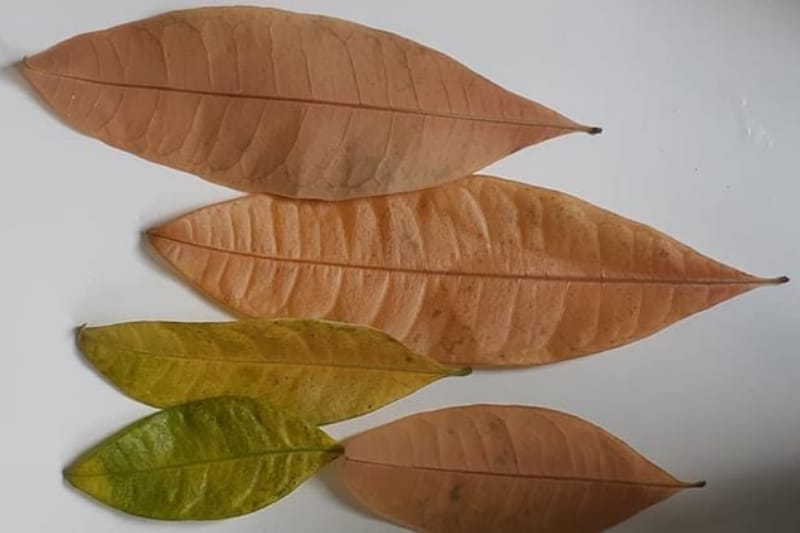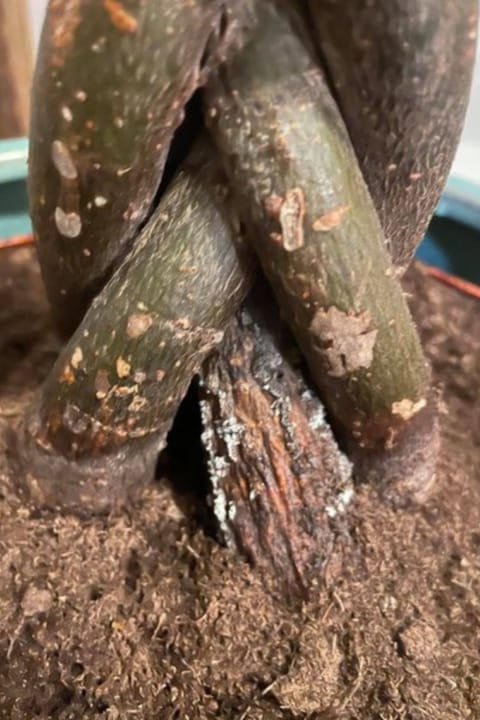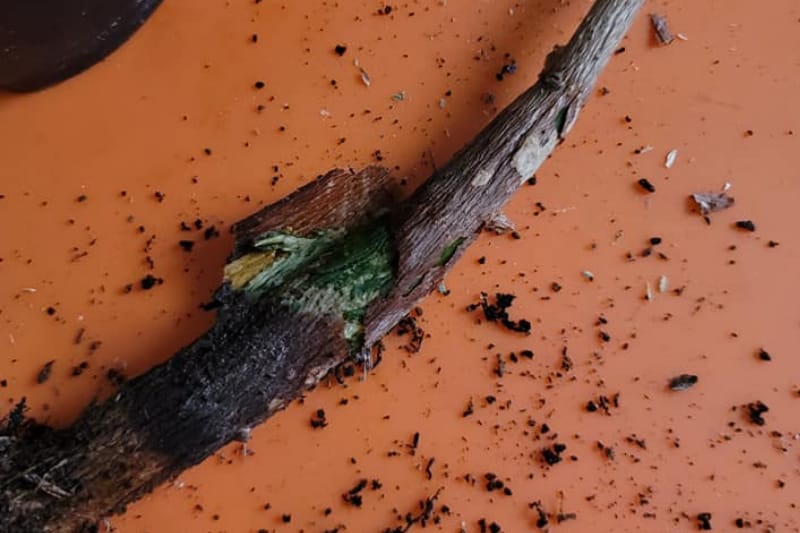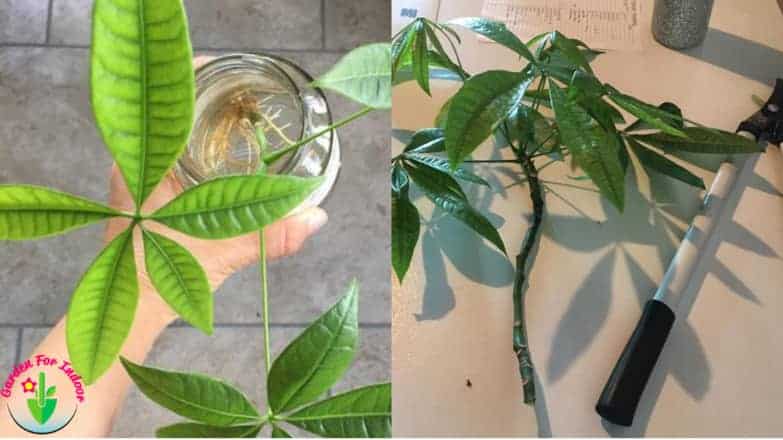Despite your best efforts, you might notice that your money tree’s vibrant green leaves are turning yellow and falling off, or the sturdy trunks are becoming mushy. You might even find yourself completely baffled or suspecting your money plant is succumbing to root rot.
As the name implies, root rot is a disease that targets and destroys the roots of your plant. This disease often starts from the tip of the root, initially affecting the fine root hairs crucial for absorbing oxygen from the soil’s air pockets.
When the roots die, they can no longer absorb the nutrients needed for the plant to thrive. This decay stimulates the fungal growth in the roots and facilitates the decomposition of the plant root. Starting from the root tip, the fungus continues to expand its reach until it gets to the trunk or stem, which can eventually lead to the death of the plant.
Ideally, you should be able to detect the root rot in its early stages, when the damage is confined to the root itself. However, by the time you notice discoloration of the leaves and a mushy or soft texture to your money tree’s trunk, it’s often too late.
If you are fortunate enough to catch the root rot in its infancy, cutting off the diseased roots and repotting the plant in fresh new soil can potentially halt the progress of the disease, giving you a chance to save your beloved money tree from an untimely end.
Contents
Why Your Money Tree Has Root Rot
There could be several causes for root rot in your money tree, but the most common one is overwatering. In fact, I’ve discovered that overwatering accounts for 90% of the cases leading to this destructive disease in money trees.
As you may already know, plants consume carbon dioxide from the air through their leaves, creating oxygen and water. However, they also need oxygen to carry out their physiological functions, which they absorb through their roots along with water.
When root rot takes hold, it damages the roots, inhibiting their ability to absorb oxygen. This lack of oxygen suffocates the leaves and roots, ultimately weakening the entire money tree.
You might be wondering how roots manage to absorb oxygen while being buried in soil. The soil is full of tiny spaces, or pores, which are essentially pockets of air containing oxygen. When you water your plant, the water pushes the air out of these pockets.
As the water drains, the pockets refill with air and oxygen. If the soil doesn’t have sufficient drainage, the moisture becomes stagnant around the root zone, creating an issue when the water doesn’t drain away within a certain timeframe.
As a result, the roots of the money tree are denied access to oxygen. There may be some oxygen dissolved in the water, but it’s not enough. Stagnant water blocks the flow of oxygen-rich air into the soil around the roots, leading to root suffocation.
Furthermore, without oxygen, an anaerobic condition is created, which favors fungal and bacterial growth. As the root doesn’t get enough oxygen, it starts to disintegrate or dry out, and fungal activity increases, leading to root rot. This is the starting point of the destructive path root rot takes.
Recognizing Root Rot in Your Money Tree Based on Appearance and Color
The onset of root root in your money tree can be identified early on through careful observation of the plant’s overall appearance and the color of its leaves. This early detection could potentially save your plant from a complete demise. Let’s categorize the symptoms of root rot in a money tree into three stages: early, middle, and late.
Early Stage – A Strange Odor from the Roots
Does your Money tree seem wilted or distressed? If so, you may wonder if root rot is the cause. To confirm this, examine the root system. Carefully remove the plant from its pot to ensure you don’t miss this opportunity for early detection.
If you notice an unusual smell from the soil or roots, it’s a likely sign that your money tree is beginning to suffer from root rot. Be especially observant during watering; if the water running out from the drainage holes carries a foul smell, it’s pretty clear your plant has root rot lurking beneath the soil.
Thankfully, at this stage, the rot is usually confined to a limited part of the root system. If you address the issue promptly, your plant stands a good chance of fully recovering.
Middle Stage – Withered Leaves and Brown Discoloration
Despite your efforts to nurse your money tree back to health with water, fertilizer, and a cool environment, the leaves continue to wither and lose their vigor. If that’s the case, your money tree is likely suffering from root rot and has reached the middle stage.
The root damage is preventing essential nutrients and water from reaching the tips of the leaves. If the leaves are not just withering but also turning brown, this indicates that the root rot is at a severe stage.
Late Stage – The Trunk Becomes Soft and Mushy, and the Bark Peels Off
A soft, mushy trunk with easily peeling bark is a likely sign of an advanced stage of root rot.
This suggests that the root rot has spread from the main root system to the trunk and may continue to other parts of the plant. Unfortunately, recovery from this stage can be quite challenging.
How to Treat and Revive a Root-Rot Affected Money Tree
Reviving a root rot-affected plant like your money tree needs careful steps and timely action. I’m here to guide you on how to breathe new life into your ailing money tree.
Treating money tree root rot hinges on the rot’s progression; remember, the closer the rot gets to the trunk and main root system from the tips of the fine root fibers, the tougher the task becomes.
Therefore, successfully bringing your money tree back to health from root rot is largely dependent on your speed. It’s crucial to identify the disease promptly and act without delay.
1- Early Stage Root Rot: Revive Your Money Tree by Drying the Soil
Caught in its early stages, root rot can be remedied simply by drying out the soil of your money tree.
For extra assurance, consider repotting the plant using fresh potting soil, and while you’re at it, trim off any discolored roots (soft brown or black). Use a fungicide solution on the remaining healthy roots to kill any remaining root rot fungus.
For the treatment of Fungal diseases. Here are the fungicides i recommend:
| Name of The Fungicide | Amount | Amount of Water |
| Garden Safe Brand Fungicide3 | 2 tablespoons (1 fl oz) | 1 gallon of water |
| Bonide 811 Copper 4E Fungicide | 1-4 tablespoons (.05-2.0 fl oz) | 1 gallon of water |
| Southern Ag – Liquid Copper Fungicide | 3-4 tablespoons | 1 gallon of water |
After this, it’s important to avoid overwatering or letting stagnant water accumulate at the bottom of the pot. Ensure that water can freely drain through the potting mix and out of the drainage holes.
The type of potting mix you use plays a critical role here – choose one that drains excess moisture well. And don’t forget about the pot; it needs to have functional drainage holes.
Remember to empty any leftover water from the saucer underneath your money tree. To aid recovery, move the plant to a spot that gets plenty of sunlight and has good air circulation. For the time being, it’s best to hold off on watering the plant.
A helpful tip you might consider is adding a layer of activated charcoal at the bottom of your pot. Not only does it absorb surplus water, keeping the soil from becoming too soggy, but it’s also a brilliant way to keep fungal growth at bay. So, don’t forget this lifesaver when potting your next plant!
2- Tackling Mid-Stage Root Rot: Saving Your Plant through Trunk Cutting Propagation
In the mid-stage of root rot, simply drying out the soil and repotting often proves ineffective. This root rot progresses up from the roots to the trunk, and then extends to the branches and leaves, eventually overwhelming the entire plant and leading to its demise.
In such a scenario, to salvage your money tree, you’ll need to resort to propagation through root cuttings. To kickstart this process, cut the trunk that has been afflicted by root rot, and take a cutting from the healthy part of the trunk. Make sure to remove all dying leaves and branches, if any.
Money trees are incredibly resilient. If you plant a healthy cutting in fresh soil, roots will typically sprout within 6-8 weeks (1.5-2 months), and you’ll see a revitalized money tree begin to flourish once again.
Once the cutting has rooted, water it generously initially to help it establish, then gradually reduce the watering to encourage more extensive root growth. Letting the soil slightly dry out is a good technique.
A good way to confirm the success of your cutting is to look for new shoots. If you notice new growth within 10 to 12 days, you can consider your cutting a success.
3- Late Stage Root Rot: Determining if Your Cutting is Still Viable
The process of saving a money tree severely affected by late-stage root rot is much like our previously mentioned method for dealing with middle-stage root rot. Essentially, the key is to growing a new plant from a cutting taken from a healthy part of the original money tree.
As this is the late stage of root rot, the decay has likely advanced to the tree’s trunk and is spreading to the branches and leaves. Your task is to locate a healthy section at the very top of your plant and take cuttings from it. By rooting these cuttings in clean soil, you can propagate a new, healthy plant.
But how can you determine if your cutting is still viable, especially when it’s taken from a tree in such late-stage decay? There’s a simple method: examine the cut end of your cutting. If it’s clean and white, that section of the trunk is still alive and suitable for propagation.
It’s important to emphasize that you should not use old potting soil when rooting these cuttings. Opt for new potting soil or disinfected soil instead – this can make a significant difference.
Believe me, I’ve experienced this firsthand. This method turned my situation around and allowed me to keep my money tree through successful propagation.
Preventing Root Rot and Fostering Healthy Growth in Your Money Tree
If you’ve successfully addressed root rot in your money tree using the steps I’ve shared earlier, I’m sure you’d like to keep it at bay for good. Here are three simple, yet effective tips for maintaining a healthy money tree and preventing root rot:
- Adapt Your Watering Routine: Depending on the season, you’ll need to tweak your watering schedule. A helpful strategy I’ve found is to simply use your finger to gauge the soil’s moisture level which I will share in the next part.
- Provide Moderate Sunlight: A balanced amount of sunlight is essential for your money tree. It’s not only vital for photosynthesis, but it also helps regulate the plant’s water uptake, evaporation from the pot, and overall soil condition. With the right amount of sunlight, your potting soil won’t turn soggy or damp, reducing the risk of root rot significantly.
- Ensure Good Ventilation: A well-ventilated area is crucial for your money tree’s healthy growth. Proper air circulation helps ward off fungal diseases and inhibits fungal growth. Place your Money tree where it won’t be hit by direct AC wind, and if you notice the leaves getting dry, spritz them with water.
Watering Tips to Avoid Overwatering Your Money Tree
If you prefer sticking to a strict watering routine, I recommend watering every two to three days during the growing season. The money tree is native to tropical regions that are warm and humid.
It thrives during the warmer months, from April to September when it grows rapidly and requires more water.
It makes sense why plants need more water during the growing season. The warm temperatures ramp up the plant’s physiological and growth activities, which require both nutrients and water.
The plant also uses more water to stay cool and facilitate transpiration through its leaves. Without adequate water, these vital activities are impaired, stressing the plant.
Yet, some folks inadvertently overwater their money trees, thinking that they might not be able to water them later in the week. Unfortunately, this approach can harm your money tree and invite problems like root rot.
After many years of nurturing houseplants, I’ve discovered a technique to prevent overwatering, and it works like a charm.
Embrace the chance to get your hands dirty! Instead of using a moisture meter, I simply use my fingers to check the soil’s moisture.
You can use a moisture meter if you’re uncomfortable touching the soil frequently, but I’ve found that sometimes the readings aren’t as accurate as I’d like.
Simply insert your finger up to the second knuckle or about 1 to 2 inches (2.5 to 5 cm) into the topsoil and gauge the moisture level. If the soil feels moist, you can hold off on watering, but if it’s dry, your plant needs water immediately. Following this method, I guarantee you’ll avoid overwatering your money tree.
Watering During The Dormant Period Like Winter
During the winter, your money tree enters a dormant phase, which means it slows down its growth. Because of this, the tree’s physiological activities also decrease, reducing its need for water compared to the summer season. Therefore, adjusting the watering frequency and amount based on the season is essential.
If you’re seeking a guideline, watering your money tree every 4 to 7 days is generally sufficient during the winter. It’s vital, though, to water your tree thoroughly each time.
This means you should water until it starts to seep through the bottom of the pot, which helps refresh the air in the soil.
However, be cautious of the water temperature during the cold winter months. Extremely cold water can harm the tree’s root system and subsequently affect the overall health of the plant. Using lukewarm water, around 59 to 68°F (15 to 20°C), is a safer option.
Overwatering during winter dormancy can pose a risk. As the plant has a lower requirement for water during this period, excess water can create an overwatered environment.
Following the summer’s watering routine can lead to root rot, a problem you certainly want to avoid. By adhering to the above advice, you can easily prevent this issue and ensure your money tree’s healthy growth.
Here’s how to take care of your money tree in winter to ensure its continued thriving in the upcoming season.
Frequently Asked Questions About Money TreeRoot Rot
Q- I removed the rotting trunk from my braided Money Tree. Can I just leave the rest alone?
While it might be tempting to simply leave the rest of your braided Money Tree alone after removing the rotten trunk, this isn’t something I would advise.
The risk of root rot fungus spreading to other trunks is substantial, which is why I’d strongly suggest replanting in a new pot. If it’s winter and your Money Tree isn’t currently growing, try filling the existing pot with fresh, clean soil and waiting for the warmer season to arrive.
It’s crucial to remember that a braided Money Tree isn’t a single plant – it’s a group of saplings grown together. This structure can retain moisture and is susceptible to various diseases, so you’ll need to be vigilant and regularly monitor its growth conditions.
Q- After cutting off the rotting trunk, can I replant it as is?
Yes, you can replant the trimmed trunk as is, but I’d suggest lightly applying a rooting hormone or disinfectant to the cut surface. This can help prevent any fungal infections on the wound.
Personally, I find ordinary cinnamon powder effective for cuttings, thanks to its antifungal properties and its ability to act as a rooting hormone.
Another key point is the tool you use for cutting. Be sure to use a sharp blade or shears to avoid damaging the trunk’s fibers. And don’t forget to use fresh, clean soil when you replant – it’s crucial for the plant’s health and getting rid of root rot.














